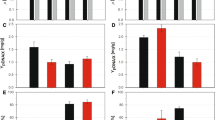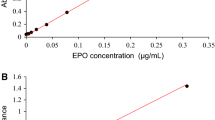Summary
Experiments were carried out to assess the survival of recombinant plasmid DNA during large-scale production of recombinant human erythropoietin (rhuEPO) in a fermentation pilot plant. The analyses revealed DNA-degrading activities in the fermentation broth and in the waste-water, leading to rapid destruction of plasmid DNA added to medium or waste-water. The capability of the plasmid-DNA-spiked samples to transform competent bacteria was drastically reduced. The DNA-degrading activity in the waste-waters could be blocked by addition of EDTA or by boiling, indicating the presence of DNA-degrading enzymes (DNases). No plasmid-specific DNA sequences were detected in waste-water samples by in-vitro amplification with Taqpolymerase. Genomic DNA preparations of cell debris collected from waste-water samples only contained degraded plasmid DNA. Furthermore, it was shown that intact plasmid DNA could be degraded to fragments of less than 1000 bp by incubation at 121°C for 20 min, leading to a decrease in the plasmid-specific transforming capacity by a factor of 103 per minute. Thus, DNA from the rhuEPO production pilot plant was efficiently inactivated at three different levels: (i) in the fermentation medium (DNase), (ii) in the waste-water container (DNase), and (iii) by heat inactivation for 20 min at 120°C. These results indicate that the probability of delivery of recombinant DNA into the environment is extremely low in such biotechnological production processes.
Similar content being viewed by others
References
Campbell VW, Jackson DA (1980) The effect of divalent cations on the mode of DNaseI. The initial reaction products produced from covalently closed circular DNA. J Biol Chem 255:3726–3735
Chen EY, Howley PM, Levinson AD, Seeburg PH (1982) The primary structure and genetic organization of the bovine papillomavirus type 1 genome. Nature 299:529–534
Dvoretzky I, Shober R, Chattopadhyay SK, Lowy DR (1980) A quantitative in vitro focus assay for the bovine papillomavirus. Virology 103:369–375
Dynan WS, Tijan R (1983) Isolation of transcription factors that discriminate between different promoters recognized by RNA polymerase II. Cell 32:669–680
Fiers W, Contreras E, Haegeman G, Rogiers R, Voorde A van de, Heuverswyn H van, Herreweghe J van, Volkaert G, Ysebaert M (1978) Complete nucleotide sequence of SV40 DNA. Nature 273:113–120
Graham FL, Eb AJ van der (1973) A new technique for the assay of infectivity of human adenovirus 5 DNA. Virology 52:456–467
Hamer DH, Walling M (1982) Regulation in vivo of a cloned mammalian gene: cadmium induces the transcription of a mouse metallothionein in SV40 vectors. J Mol Appl Genet 1:273–288
Hanahan D (1983) Studies on transformation of E. coli with plasmids. J Mol Biol 166:557–580
Hsiung H, Fitts R, Milne A, Aamer D (1984) Efficient production of hepatitis B surface antigen using a borine papillomavisus-metabollothionein vector. J Mol Appl Genet 12:497–506
Jacobs K, Shoemaker C, Rudersdorf R, Neill SD, Kaufmann RJ, Mufson A, Seehra J, Jones SS, Hewick R, Fritsch EF, Kawakita M, Shimizu T, Miyake T (1985) Isolation and characterization of genomic and c-DNA clones of human erythropoeitin. Nature 313:806–810
Lusky M, Botchan M (1981) Inhibition of SV40 replication in simian cells by specific pBR322 DNA sequences. Nature 293:79–81
Messing J (1983) New M13 vectors for cloning. Methods Enzymol 101:20–78
Primrose SB (1986) The application of genetically engineered microorganisms in the production of drugs. J Appl Bacteriol 61:99–116
Sanders E, Egyptien RAK, Deckwer W-D (1990) Thermische Inaktivierung rekombinanter DNA. BioEngineering 6:29–33
Southern EM (1975) Detection of specific sequences among DNA fragments separated by gel electrophoresis. J Mol Biol 98:503–517
Tatchell K, Holde KE van (1978) Compact oligomers and nucleosome phasing. Proc Natl Acad Sci USA 75:3583–3587
Wurm F, Zettlmeissl G (1989) Biotechnologische: Herstellung von Biologika für die Medizin. BioEngineering 5:42–50
Author information
Authors and Affiliations
Additional information
Offprint requests to: M. R. Fibi
Rights and permissions
About this article
Cite this article
Fibi, M.R., Bröker, M., Schulz, R. et al. Inactivation of recombinant plasmid DNA from a human erythropoietin-producing mouse cell line grown on a large scale. Appl Microbiol Biotechnol 35, 622–630 (1991). https://doi.org/10.1007/BF00169627
Received:
Accepted:
Issue Date:
DOI: https://doi.org/10.1007/BF00169627




